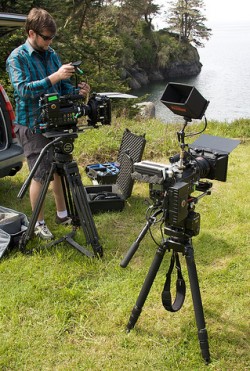
I recently had the pleasure of helping out on a music video shoot here in the northwest, noteworthy not just because a great video resulted, but because we were shooting with two RED One cameras and a custom RC helicopter for aerial shots. It was interesting being behind the scenes and I thought I’d share a little of the fun. The video itself, for Mt St Helens Vietnam Band’s “Albatross, Albatross, Albatross,” can be viewed in HD over at Vimeo.
The opportunity to see a group of local freelancers and entrepreneurs coming together to make such an incredibly professional product was extremely valuable — technology has democratized and accelerated the independent film and music community to a degree I hadn’t realized. I was brought on because I had access to some special locations (most of the aerial and forest shots are near some family property in the San Juans) and so I could shoot a little behind-the-scenes video of the production. Go ahead and check out that video below.
 The above contains video shot by me as well as production stills by both myself and the director, Matt Daniels of ThinkLab. Matt edited it, since I was taking forever.
The above contains video shot by me as well as production stills by both myself and the director, Matt Daniels of ThinkLab. Matt edited it, since I was taking forever.
We had two RED Ones to shoot with, which is rare to find anywhere, really. With careful lens selection, this allowed for some really great multi-angle shots without change in continuity or video quality. For instance, we had Marshall, the drummer of the band, wading in the water in extremely low light (torchlight). One camera was shooting handheld, up close with a wide angle, and the other was about 30 feet away, with a longer lens in a more stationary position. It allows the director and editor to work freely with the scene without worrying about continuity errors, and can also drastically cut down on the time a poor drummer has to be standing in freezing cold water at midnight.
Lastly, the all-digital process makes for such a streamlined workflow that, if we didn’t have to catch a ferry, we could have had a rough cut put together the next day — a huge benefit when you’re working directly with a client, as we were with the band. As one might imagine, this can lead to sloppy productions put together without the caution and care that comes with working in a valuable medium like film — and some people assume that because it’s possible, it’s expected. But that’s as far from the truth as the idea that a film medium guarantees a quality end result. Digital cinema tools simplify the workflow, but they don’t simplify the product.
The helicopter you see is owned and operated by AerialPan Imaging’s founder, Tabb Firchau. I subjected him to a brief interview:
So the camera on the heli is a Panasonic HVX, which accounts for the difference in texture and tone you see in the video. I noticed a similar effect while watching Planet Earth; the Varicams they used for much of the series weren’t able to be used under water, so they used some sort of smaller Sony (I believe) camera for those sequences. The video quality isn’t as high, but the Sony and HVX are far more light and compact than a Varicam or RED One — handy in those underground caverns, or when you need to fly it at 50MPH over water in an RC helicopter.

I was struck by the amount of specialized gear used by both Tabb and the RED operators (Mike Prevette on heli and DP Michael Ragen). Jury-rigged solutions for missing or broken parts, custom fast-charging battery packs, and the lenses… oh, the lenses. And of course, it was interesting seeing the familiar forest and beach we were tramping around on metamorphose into the evocative landscape of the video.
It’s amazing how democratized high quality stuff like this has come, with the advent of (relatively) affordable HD cameras like the RED and pro editing and effects software that can be brought with you to the field. Thanks, crew — it was a fun and interesting look at the soft underbelly of cinematic production.